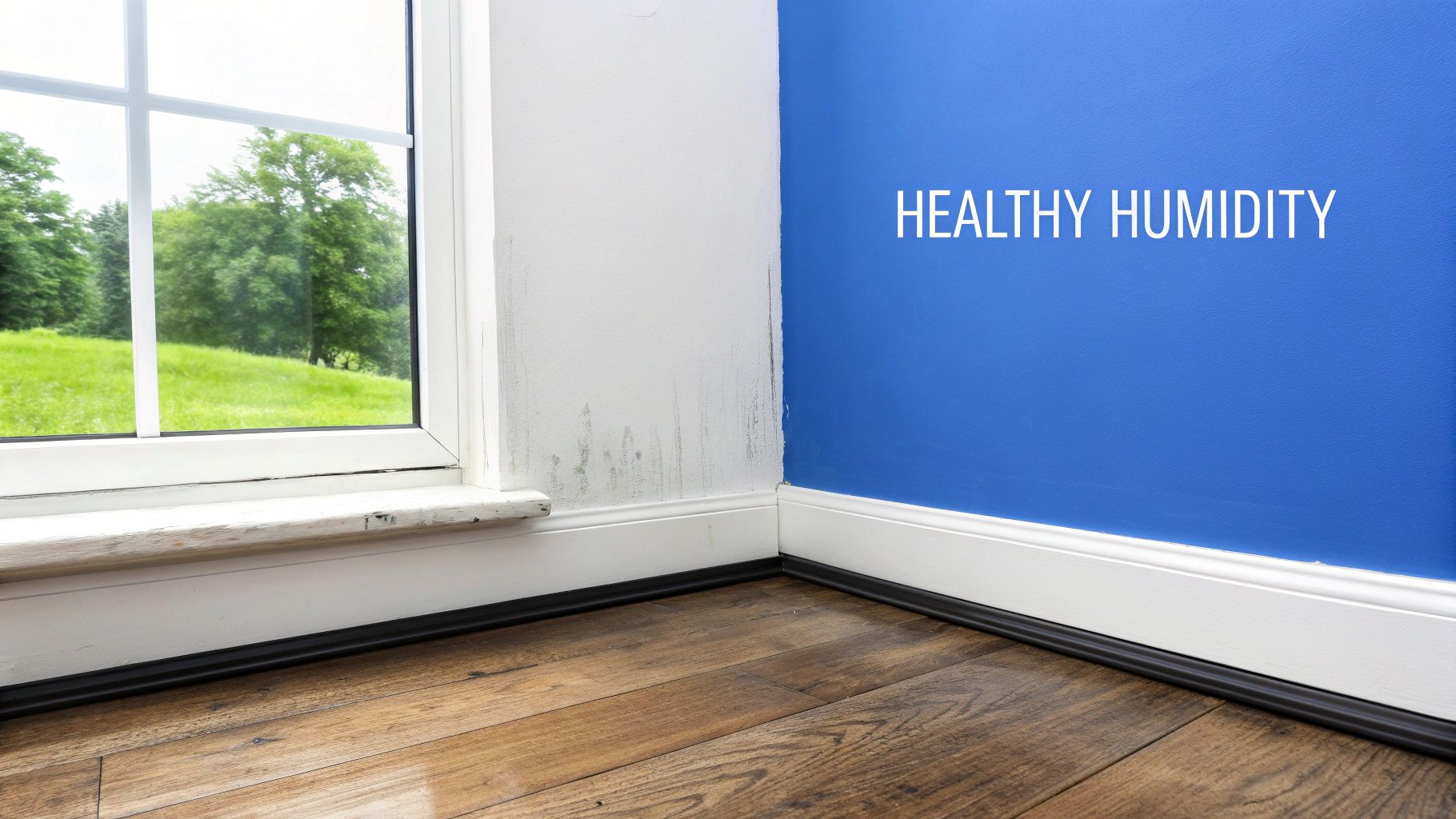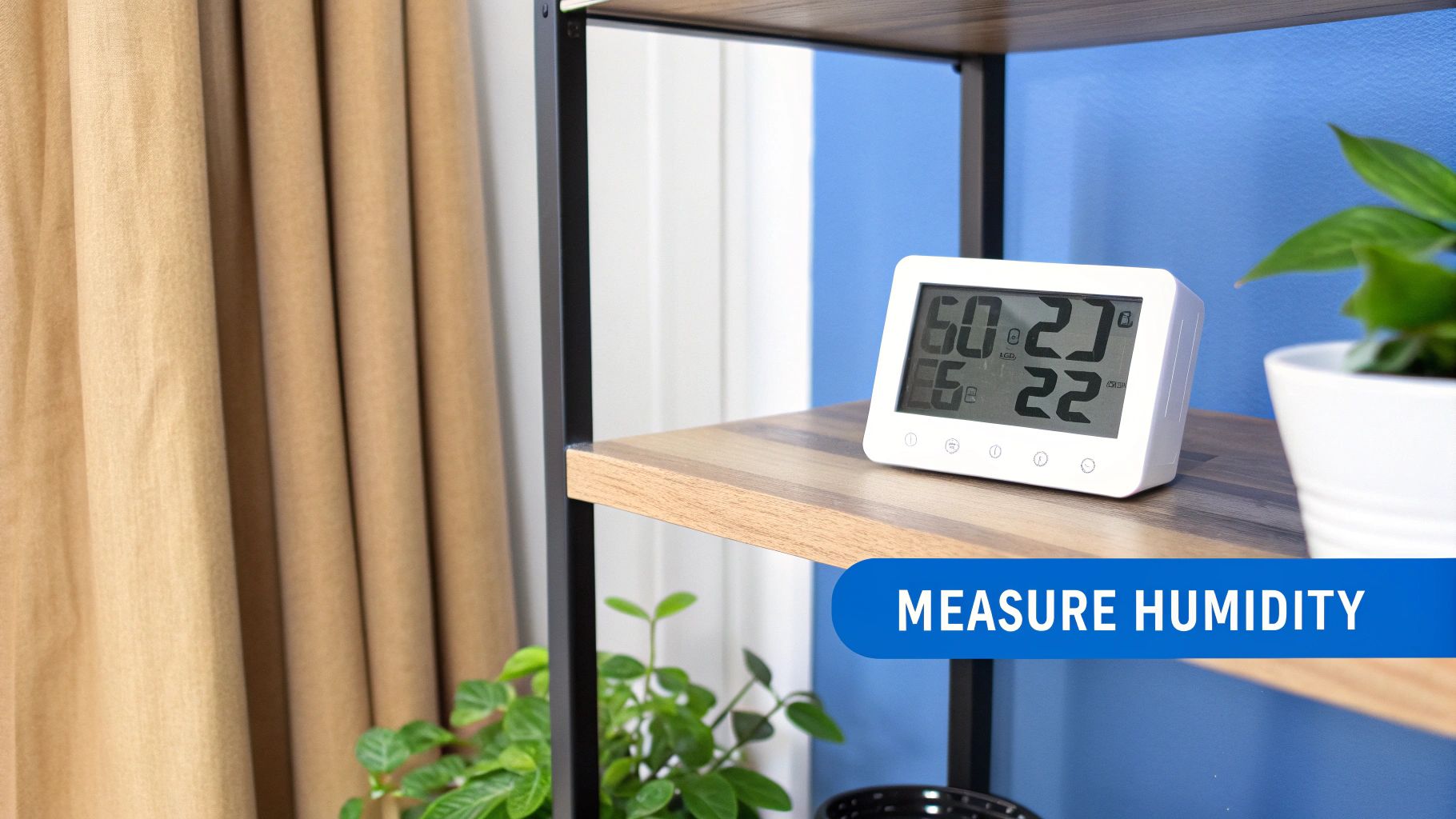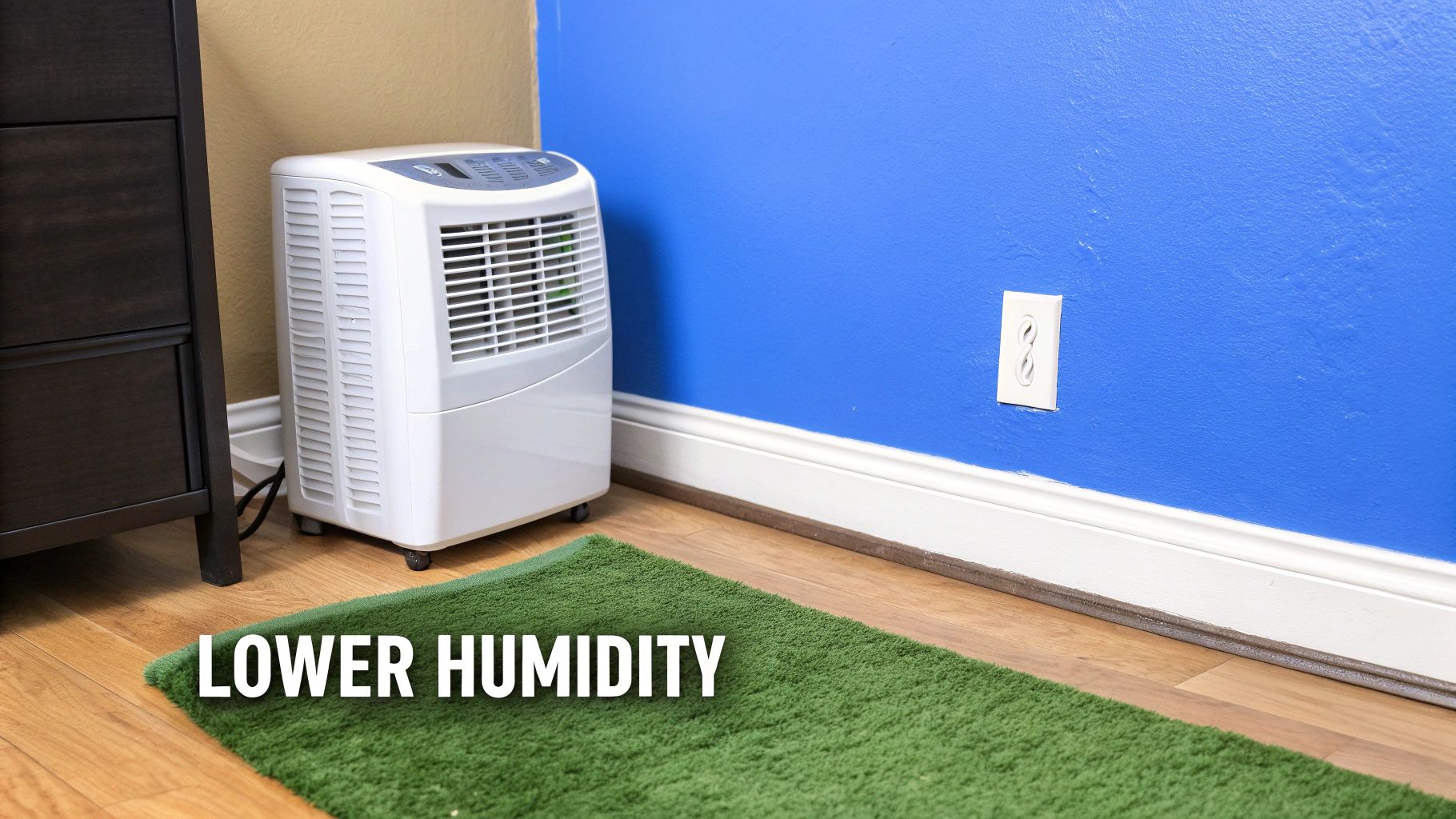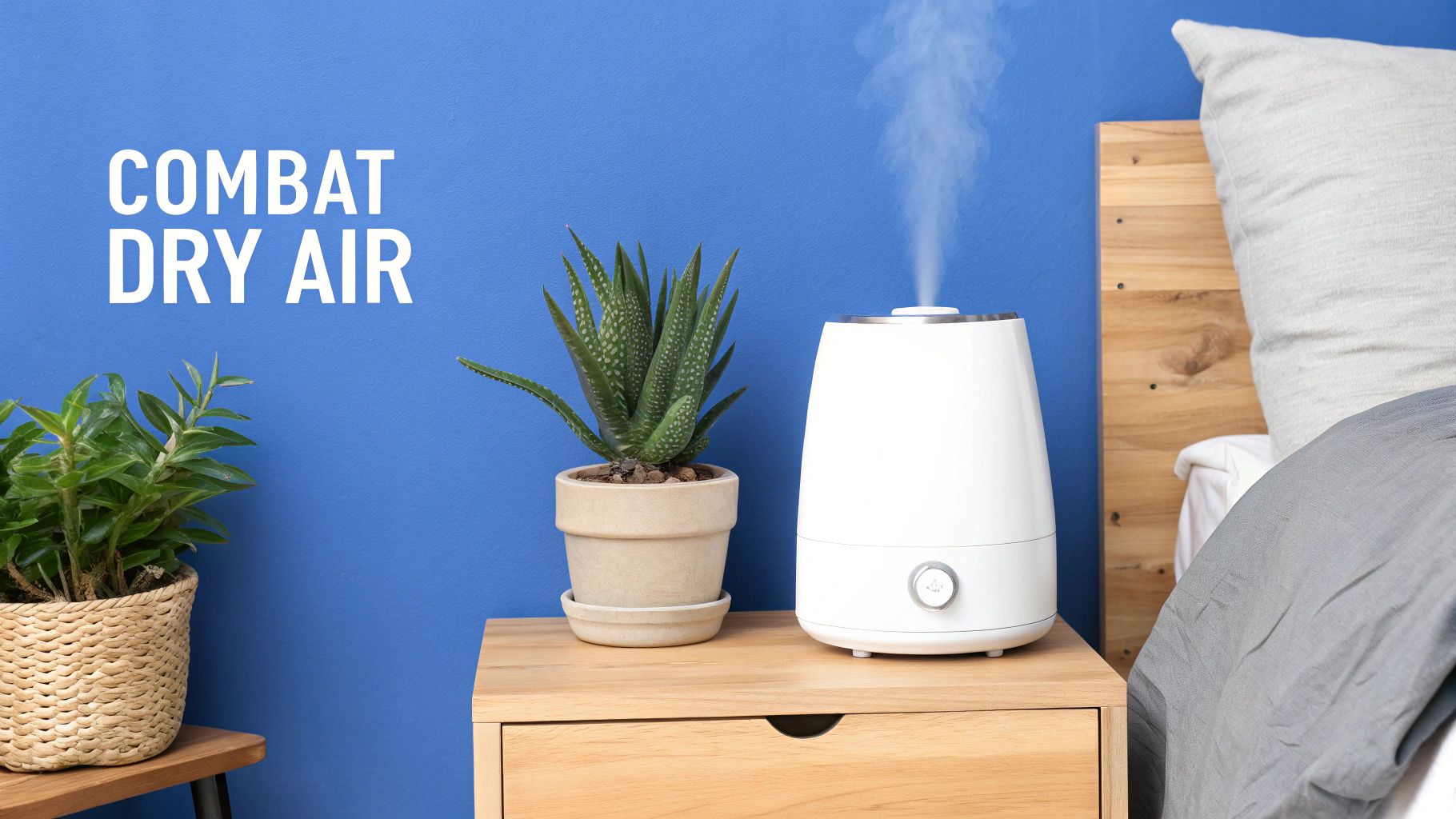Keeping a handle on your home’s humidity isn't just about comfort—it's about protecting your property and your family's health from the ground up. The goal is to strike a healthy balance, keeping your indoor relative humidity somewhere between 30% and 50% all year round. Stray too far outside that range, and you’re inviting trouble.
Why Humidity Control Is Essential for Your Home
That subtle musty smell in the basement or the condensation that won’t quit fogging up your windows? Those aren’t just minor annoyances. They're clear signals that your home’s internal environment is out of balance. When humidity levels creep too high, the fallout can be both expensive and seriously detrimental to your health.
Excess moisture in the air creates the perfect breeding ground for things you definitely don't want sharing your space. This is the single most important reason to get your humidity under control.
- Mold and Mildew Growth: These fungi thrive in damp, dark conditions—often hiding behind walls or in crawl spaces. They release spores into the air that can kick up allergies and lead to significant respiratory issues.
- Dust Mite Infestations: Dust mites, a major allergen, literally pull moisture from the air to survive. High humidity lets their populations explode, making life miserable for anyone with allergies or asthma.
- Bacterial Growth: Certain types of bacteria also flourish in moist environments, which only adds to the degradation of your indoor air quality.
Protecting Your Property and Your Investment
Beyond the health concerns, uncontrolled moisture wages a slow but steady war on your home's structure and everything in it. Think of high humidity as a slow-motion flood; the damage just keeps accumulating over time.
For example, porous materials like wood soak up all that extra moisture from the air. This can cause hardwood floors to swell and warp, furniture joints to loosen, and even structural beams to weaken. You might also see paint blistering on the walls or wallpaper peeling at the seams—that's the moisture breaking down the adhesive.
High humidity doesn't just make a room feel sticky and uncomfortable—it actively works against your home's structural integrity and the health of everyone inside. Your air conditioner has to work harder, wood starts to warp, and allergens have a field day.
The Problem of Low Humidity
On the flip side, air that’s too dry brings its own set of problems. This is especially common during colder months when our heating systems are working overtime. When the humidity drops below 30%, you’ll likely start to notice:
- Dry, itchy skin and irritated sinuses
- An annoying increase in static electricity shocks
- Cracks appearing in wood furniture, flooring, and even musical instruments
Getting your home’s humidity right is a delicate balance, but it’s a non-negotiable part of home maintenance that directly impacts your comfort, health, and property value. A crucial first step is understanding the specific humidity levels at which mold begins to grow. Once you master this balance, you create a sanctuary that isn’t just comfortable, but truly safe and sound.
How To Accurately Measure Your Home’s Humidity
Before you dive into dehumidifiers or ventilation tweaks, you’ve got to know exactly where your indoor air stands. Relying on how the air “feels” can only take you so far. A proper humidity audit turns guesswork into clear, actionable numbers.
That’s where the right tools and a few smart observations come together. Think of it as your home’s health check—pinpointing trouble spots and setting you up for comfort, energy savings, and mold prevention.
Choosing Your Primary Tool: The Hygrometer
A hygrometer sits at the heart of any humidity-control plan. It translates moisture levels into a simple relative humidity (RH) percentage, and without that data, you’re flying blind.
There are two main varieties to consider:
-
Digital Hygrometers
User-friendly displays, temperature readings, memory functions and battery power. Most homeowners opt for these for their accuracy and ease of use. -
Analog Hygrometers
Battery-free, dial-style instruments that look charming but need periodic calibration to stay on point.
For the majority of houses, investing in a few reliable digital units is all you need to get started. In fact, the global humidity sensor market hit $3.96 billion in 2025 and is projected to nearly double by 2032—partly thanks to integration in smart-home platforms. You can dive deeper into the numbers in this humidity sensor market report.
Strategic Placement For Accurate Readings
Even the best hygrometer will mislead you if it’s in the wrong spot. Location matters just as much as device quality.
Aim for the heart of your living space. A hallway table or a bookshelf in the family room is ideal—somewhere sheltered from spikes in moisture or heat.
Avoid these common missteps:
- Kitchens & Bathrooms: Temporary steam waves won’t reflect the rest of the house.
- Near Windows or HVAC Vents: Direct sun, drafts, and airflow skew results.
- On the Floor: Humidity can vary by height—place it at least shoulder-level.
If you suspect trouble in the basement, attic, or a clammy guest room, scatter a few extra hygrometers around. Comparing readings room by room reveals true hotspots.
Ideal Indoor Humidity Levels By Season
To keep things straightforward, here’s a quick reference for target RH throughout the year. Adjusting your settings with the seasons will save energy, protect wood features, and curb mold growth.
| Season | Ideal Relative Humidity (RH) | Primary Goal |
|---|---|---|
| Spring | 40–60% | Minimize pollen and mellow temperature swings |
| Summer | 40–55% | Prevent mold and keep cooling bills in check |
| Fall | 35–50% | Protect wood furniture and prepare for cooler air |
| Winter | 30–40% | Combat condensation and maintain comfort |
By aligning your humidifier or dehumidifier settings with these ranges, you’ll strike the sweet spot between comfort and health.
Learning To Read Your Home’s Physical Clues
Your senses are the second piece of the puzzle. A hygrometer may flag 55% RH, but your basement walls and hallway hallway should back it up with visible signs or smells.
If you’re regularly above that threshold, it might be time to schedule a professional mold check. A certified team can unearth hidden moisture before it becomes a full-blown remediation job. Learn more about thorough mold inspection service.
A musty smell is more than just an odor—it’s often the first and most obvious sign of a hidden moisture problem that is actively encouraging mold or mildew growth somewhere in your home.
Watch for these tell-tale signs of high humidity:
- Condensation collecting on windows, mirrors, or cold pipes
- That lingering damp or musty odor in closets or basements
- Mold or mildew spots around showers, ceilings, or behind furniture
- Blistering paint or peeling wallpaper
- Sticking wood doors and windows
And don’t overlook the flip side—low humidity clues:
- Frequent static shocks
- Dry, itchy skin or irritated sinuses
- Cracks in wood floors, trim, or musical instruments
By blending precise measurements with what you see and smell, you’ll stay ahead of humidity swings—protecting both your home and your well-being.
Practical Ways to Reduce High Humidity
When your home feels perpetually damp and stuffy, that's a clear signal that excess moisture has overstayed its welcome. This is your practical playbook for getting that moisture under control—moving beyond theory and into actionable solutions that restore balance and comfort to your living space.
For most homeowners, the first line of defense is a dehumidifier. These appliances are workhorses, designed specifically to pull water vapor right out of the air. They are central to managing humidity, especially in notoriously damp spots like basements, crawl spaces, and bathrooms.
It's no surprise the market for these units is growing. The global dehumidifier industry, valued at around USD 5.6 billion in 2025, is expected to climb to USD 9.2 billion by 2035. This trend reflects a rising awareness of just how critical indoor air quality is for our health. You can dig into more of these trends in this in-depth industry report.
Choosing the Right Dehumidifier
Not all dehumidifiers are created equal. Picking the right one means matching the unit's capacity—measured in pints of moisture it can remove in 24 hours—to your specific space and problem.
- For smaller, moderately damp spaces like a bedroom or home office (up to 1,500 sq ft), a 30-pint unit usually does the trick.
- For larger or wetter areas like a living room or a damp basement (up to 2,500 sq ft), you'll want to step up to a 50-pint model.
- For very wet, large basements or crawl spaces dealing with significant moisture, a 70-pint workhorse is what you need to make a real impact.
Here's a pro tip: it's always better to slightly oversize your unit than to undersize it. An underpowered dehumidifier will run constantly without ever hitting your target humidity, just wasting energy and causing frustration.
Types of Dehumidifiers Explained
Beyond just pint capacity, dehumidifiers fall into a few key categories, each built for different situations.
-
Portable Dehumidifiers: These are the ones you see most often. They're standalone units, usually on wheels, that you can move from room to room. They are perfect for targeting specific problem areas, like a musty closet or a humid laundry room. Most have a collection bucket you'll need to empty, though many also offer a continuous drain hose option.
-
Whole-House Dehumidifiers: If you live in a consistently humid climate, a whole-house unit is a game-changer. These systems are installed directly into your HVAC system, treating the air throughout your entire home. It’s a "set it and forget it" solution that works quietly and efficiently in the background.
-
Desiccant Dehumidifiers: Unlike traditional compressor-based models, desiccant units use a special moisture-absorbing material (think silica gel) to pull water from the air. Their biggest advantage is that they work well in cooler temperatures (below 60°F), making them the ideal choice for unheated basements, garages, or crawl spaces where standard models would struggle.
Choosing a dehumidifier isn't just about the room size; it's about the severity of the moisture problem. A slightly damp room needs a different solution than a basement with visible condensation on the walls.
Leverage Your Existing Ventilation
While dehumidifiers are powerful tools, they work best as part of a bigger strategy. Proper ventilation is the other half of the equation, focused on physically pushing moist air out of your home before it can cause trouble.
Your goal is to create clear pathways for humid air to escape. This means getting serious about using the ventilation you already have.
- Run Exhaust Fans: The fans in your bathrooms and the range hood over your stove are non-negotiable. Run them every time you shower, bathe, or cook, and let them run for another 15-20 minutes afterward to clear out all the leftover moisture.
- Check Your Dryer Vent: Make sure your clothes dryer vents directly outside and that the vent line is clear of lint and other blockages. A clogged vent can pump gallons of moisture right back into your home with every laundry load.
- Promote Air Circulation: Use ceiling fans or even portable fans to keep the air moving. Stagnant air allows humidity to build up in pockets, but good circulation helps distribute it, making it easier for your HVAC or dehumidifier to handle.
Your Air Conditioner Is a Dehumidifier
It’s easy to forget, but your air conditioner is a powerful dehumidifying tool. As your AC runs, it pulls warm, moist air over its cold evaporator coils. This process forces the water vapor to condense out of the air, where it's collected and drained outside.
If your home feels clammy in the summer, running the AC is one of the most effective ways to lower both the temperature and the humidity. For this to work well, your HVAC system needs to be properly maintained with clean filters and clear drain lines.
Of course, if the problem keeps coming back, you might need to find the source. Investigating and addressing the root causes of moisture intrusion with professional solutions is always the most effective long-term strategy.
Effective Strategies for Combating Dry Air
While we talk a lot about the dangers of high humidity, the opposite problem—dry, stale air—can be just as frustrating. When your home's humidity dips below 30%, you start to feel it. It’s the scratchy throats, dry skin, and constant static shocks. It can even cause your wood floors and furniture to crack over time.
Bringing that moisture level back up is about more than just comfort; it’s about restoring a healthy balance to your home. Thankfully, it doesn't have to be complicated. A good humidifier, combined with a few simple habits, can make a world of difference.
Selecting the Right Humidifier for Your Space
A humidifier is your number one tool for putting moisture back into the air. It's a big market—valued at USD 2.79 billion in 2024 and expected to hit USD 4.61 billion by 2032, largely because people are more aware of how crucial humidity control is for health. You can see more on the industry's growth in this market research report.
When you start shopping, you'll find a few main types. Here's the rundown:
- Cool Mist Humidifiers: These are my go-to recommendation for homes with kids or pets. Since there’s no heating element, there's zero burn risk. They come in two styles: evaporative (uses a fan and a wick) and ultrasonic (uses vibrations to create a visible mist).
- Warm Mist Humidifiers: These boil water to create a warm, soothing steam. A big plus is that the boiling process kills off waterborne bacteria and mold before they get into your air. The trade-offs are higher energy use and a potential burn hazard.
- Whole-House Humidifiers: If you’re looking for a set-it-and-forget-it solution, this is it. These units are installed directly into your HVAC system to keep the humidity level consistent everywhere. They’re the most efficient option but do come with a higher upfront cost.
Sizing and Cleaning Your Humidifier
Don't just grab the first one you see. Size matters. A tiny unit in a big living room won't be able to keep up. On the flip side, a unit that's too powerful can pump out too much moisture, leading to condensation on windows and setting the stage for mold. Always check the manufacturer’s recommendation for room size (in square feet).
The most critical aspect of owning a humidifier isn't its features—it's your commitment to cleaning it. A dirty humidifier can disperse bacteria and mold spores into the air, doing more harm than good.
Regular cleaning is non-negotiable. Seriously. To keep your unit safe and effective, make these habits part of your routine:
- Use Distilled Water: Tap water is full of minerals that can settle as a fine white dust on your furniture and encourage bacteria to grow inside the tank.
- Change the Water Daily: Never let water sit. A quick empty, rinse, and refill with fresh water each day is all it takes to prevent buildup.
- Clean It Every Few Days: About every three days, unplug the unit for a deeper clean. A 3% hydrogen peroxide solution or plain white vinegar is perfect for disinfecting the tank and base and getting rid of any scale or film.
Natural Ways to Boost Indoor Moisture
Sometimes you don't need a machine running 24/7. You can use some simple, everyday tricks to give your home a gentle moisture boost, especially during those transitional fall and spring months.
- Bring in Houseplants: Plants naturally release moisture through a process called transpiration. Grouping a few together can create a nice little humid microclimate.
- Air-Dry Your Laundry: Skip the dryer and set up a drying rack indoors. As your clothes dry, all that water evaporates right into the air.
- Leave the Bathroom Door Open: After a hot shower, let that wonderful steam escape into the rest of your home instead of trapping it in the bathroom.
- Place Bowls of Water Near Heat Sources: A classic trick for a reason. A heat-safe bowl of water near a radiator or heating vent will slowly evaporate, adding a steady, gentle amount of humidity to the air.
Targeted Solutions for Different Rooms and Seasons
Controlling humidity effectively isn't a "set it and forget it" kind of deal. The strategy that keeps your sunny living room comfortable will completely miss the mark in a damp, musty basement. Different areas of your home have their own unique challenges, and your approach has to adapt not just to the room, but to the season as well.
Creating a healthy, balanced environment year-round means getting more specific than a single thermostat setting. You need targeted solutions where they matter most, from the moisture-prone depths of a crawl space to the steam-filled air of a bathroom after a hot shower.
Mastering Basements and Crawl Spaces
Below-grade areas like basements and crawl spaces are ground zero for moisture problems. Surrounded by soil, they have a natural tendency to pull in groundwater, leading to stubbornly high humidity that can fuel mold growth and create those classic musty odors.
For these spaces, a heavy-duty dehumidifier is pretty much non-negotiable. I always recommend getting a model with a continuous drain hose so you aren't stuck emptying a bucket every day. For crawl spaces, the single most effective upgrade is installing a vapor barrier—a thick sheet of plastic that covers the exposed earth. It's a game-changer that physically blocks moisture from seeping up into your home's structure. These areas are so prone to issues; understanding the common moisture problems found in crawl spaces makes it clear why they need this level of attention.
Think of your basement or crawl space as the lungs of your home. If you ignore high humidity down there, you're just letting musty, mold-spore-filled air rise and circulate through every room you live in.
Managing Moisture in Kitchens and Bathrooms
Kitchens and bathrooms are where you get short, intense bursts of humidity. A single hot shower or a boiling pot of spaghetti can send the relative humidity skyrocketing, quickly leading to condensation on walls, mirrors, and windows.
In these rooms, good ventilation is your best defense.
- Bathroom Exhaust Fan: Use it. Every single time you shower or bathe, flip that switch on. Just as important, let it run for another 15-20 minutes after you're done to make sure all that damp air is pulled completely outside. A fan with a timer switch makes this an easy habit to keep.
- Kitchen Range Hood: Your range hood isn't just for cooking smells. Use it whenever you're cooking, especially when boiling water or simmering a sauce. It's designed to pull steam and moisture right out of the room before it has a chance to spread.
These two simple habits make a massive difference in preventing the kind of lingering dampness that causes mildew on grout and makes paint start to peel.
Adapting to Seasonal Humidity Swings
Your home’s humidity needs change dramatically from one season to the next. You might go from needing to add moisture in the winter to desperately trying to remove it in the summer.
Winter Dryness
When you crank up the furnace in the colder months, it heats the air but also dries it out—a lot. That's the reason for all the static shocks, dry skin, and scratchy throats you feel in the winter. The goal here is to keep your humidity from dipping below 30%.
- Humidifiers: A portable or whole-house humidifier is the most direct way to combat that uncomfortable winter dryness.
- Natural Methods: You can also add moisture back into the air with simple tricks, like letting laundry air-dry inside or bringing in a few more houseplants.
Summer Dampness
Summer is the opposite story. The warm, humid outdoor air inevitably makes its way inside, leaving everything feeling sticky and uncomfortable. This is prime time for mold growth, so you’ll want to keep your indoor humidity below that 55-60% threshold.
Your air conditioner is a huge help, since it naturally dehumidifies as it cools. Keeping it maintained with clean filters is key to making sure it runs efficiently. But in really humid climates or for homes that just feel persistently damp, a dedicated dehumidifier working alongside your AC is the perfect combo to pull that extra moisture out and keep your home feeling fresh all summer.
Common Questions About Home Humidity Control
Even with the right tools in place, specific questions almost always pop up. Fine-tuning your home's humidity often means troubleshooting a few unique situations. Here’s a quick rundown of the most common questions we hear from homeowners, with clear answers to help you perfect your strategy.
Our goal is to give you the confidence you need to manage your home’s air quality like a pro.
What Is the Fastest Way to Lower Humidity in a Room?
The quickest way is a two-pronged attack: fire up a correctly-sized dehumidifier and immediately get some air moving. If you have an air conditioner, running it is also incredibly effective, since the cooling process naturally wrings a ton of moisture out of the air.
No AC? No problem. Open windows on opposite sides of the room to create a good cross-breeze. At the same time, turn on fans to keep the air circulating and prevent those heavy, stagnant pockets of humidity from settling in. Don't forget to run your bathroom and kitchen exhaust fans to shoot that damp air straight outside where it belongs.
Don't just rely on one method. Combining a dehumidifier with active ventilation creates a powerful synergy. You'll bring down high humidity levels in a fraction of the time it would take either solution on its own.
Can I Have a Humidity Problem Without Seeing Mold?
Absolutely. Visible mold is a late-stage symptom—it’s the final confirmation of a humidity problem that's likely been brewing for weeks, if not months. The early warning signs are much more subtle, but catching them is key.
Keep an eye (and nose) out for these clues:
- A persistent musty or earthy odor, especially in basements, closets, or bathrooms.
- Condensation that regularly beads up on cool surfaces like windows, mirrors, or toilet tanks.
- Wallpaper that has started to bubble or peel at the seams.
- A general clammy or sticky feeling in the air, even when the temperature isn't hot.
If you notice these signs, it's time to grab a hygrometer and see what your levels are. Acting now can stop mold before it ever gets a chance to take hold. If you've already found something suspicious or have concerning test results, our guide to understanding mold test results can help you figure out what to do next.
Are Whole-House Dehumidifiers a Good Investment?
For homeowners in consistently humid climates or anyone with a larger home, a whole-house dehumidifier is often an excellent investment. Yes, the upfront cost is higher than a few portable units, but the long-term benefits are huge.
These systems are tied directly into your existing HVAC setup, so they treat the air throughout your entire home quietly and efficiently. They need far less daily attention since they drain automatically and operate completely out of sight.
Ultimately, a whole-house unit offers a "set-it-and-forget-it" solution for maintaining ideal humidity levels everywhere, protecting your property and making your whole home more comfortable—not just one or two problem rooms.



